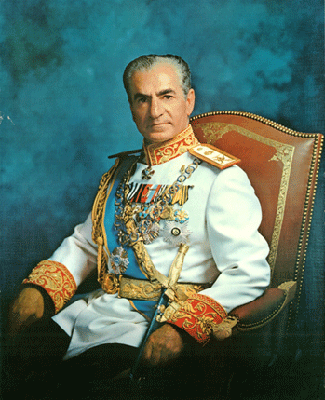
Born: October 26, 1919, Tehran, Iran
Died: July 27, 1980, Cairo, Egypt
Timeline: Mohammad Reza Shah
The son of Reza Shah Pahlavi, founder of the Pahlavi dynasty and ruler of Iran from 1925-1941, Mohammad Reza Shah Pahlavi succeeded his father on the throne. When Great Britain and the Soviet Union became concerned about Reza Shah's potential cooperation with Nazi Germany, they occupied Iran and forced the Shah into exile. Mohammad Reza Shah took his father's place on September 16, 1941. The next decade saw the Shah overseeing a people with much more freedom than they had enjoyed under his father. Iran was ruled by elected representatives, with the Shah exerting only minimal influence.
In 1951, fervent Iranian nationalist Mohammad Mosaddeq was elected to power, and the Shah appointed him Prime Minister. Mosaddeq nationalized the petroleum industry, which had been in the hands of the British and other Western powers. For this and his other nationalistic ideologies and programs, he was popular among the people of Iran, rich and poor alike. The Shah, who saw his own power at risk in the rise of Mosaddeq, tried to dismiss him as Prime Minister in 1953. Mosaddeq's supporters forced him to leave Iran, but mere days later, with the help of the United States, Mohammad Reza Shah returned to Iran. U.S. representatives, including Kermit Roosevelt - the grandson of President Theodore Roosevelt - financed a coup d'etat led by protesting crowds of the Tehran poor. Mosaddeq was vanquished, and the Shah reassumed his authority. Grateful for his American supporters, the Shah told Roosevelt: "I owe my throne to God, my people, my army, and to you" (Ebadi, p. 5).
Click here for a New York Times article describing the U.S.-backed coup against Mosaddeq.
In 1963, working with the support of the United States, Mohammad Reza Shah began a series of reforms called the White Revolution. The sweeping domestic reforms contained in this program included transportation and agricultural upgrades, in addition to measures to combat disease, promotion of industry, and land reform. The White Revolution was widely supported by the people of Iran, but it was not enough to stave off the criticisms and opposition to his rule that continued to grow. Radical reformers wanted the White Revolution's changes to occur even more quickly, while the Shah's support of Westernization was deemed a threat to Islam by religious and clerical figures. Compouding these policy concerns was the dictatorial nature of and corruption in his government. SAVAK, the Shah's secret police, worked to suppress those who openly disagreed with or opposed his rule. The Shah had failed to equally distribute Iran's ever-expanding oil wealth, the gains from which only exacerbated his regime's problems. Disenchanted by the Shah's policies and government, members of Iran's lower classes, Shi'ite clergy, bazaaris, and students turned increasingly to the exiled Ayatollah Ruhollah Khomeini for support.
His authority toppled by a string of riots and strikes, the Shah left Iran on January 16, 1979. After traveling to various countries in North Africa and the Caribbean, Mohammad Reza Shah went to the United States on October 22 to seek treatment for cancer. While there, Islamic militants seized the U.S. Embassy in Tehran, and demanded the Shah's return in exchange for the hostages they had taken. While President Carter's administration refused to comply, the Shah left the U.S. for Panama before finally settling in Cairo, Egypt, after Egyptian President Anwar el-Sadat granted him asylum. The Shah died in Cairo less than a year later, ending a life filled with both triumph and trial. While he never formally abdicated his throne, the Shah's government was destroyed for good with the Proclamation of the Islamic Republic of Iran on April 1, 1979.
Sources:
Britannica Online biography
Ebadi, Shirin. (2006). Iran awakening: A memoir of revolution and hope. Random House, New York.